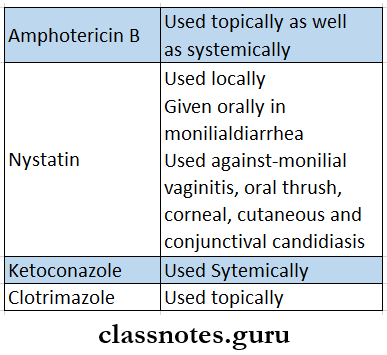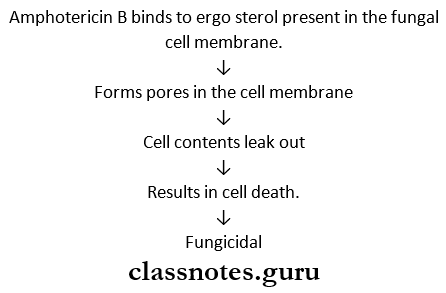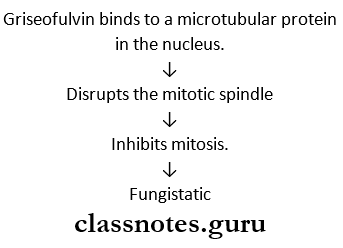Anti Fungal Drugs Important Notes
1. Antifungal drugs
- Topically applied
- Nystatin
- Trichomycin
- Systemically employed
- Griseofulvin
- Amphotericin B
- Ketoconazole
- Fluconazole
- Miconazole
Read And Learn More: Pharmacology Question and Answers

2. Nystatin- 5 lakh units are used in the treatment of
- Local candidiasis of the mouth, skin, vagina, and gut
3. Griseofulvin
- It is used to treat ringworm infections of the scalp, groin, and feet and fungal infections of the nails
- It causes antabuse like action in the presence of alcohol
4. Ketoconazole
- It produces serious hepatotoxicity.
- Contraindicated in pregnancy
- Maximum endocrinal side effects are seen
Antifungal drugs questions and answers
Anti Fungal Drugs Short Essays
Question 1. Antifungal drugs
Answer:
Antifungal drugs are drugs used for superficial and deep fungal infections.
Antifungal drugs Classification:
1. Antibiotics:
- Polyenes – amphotericin B, nystatin, natamycin.
- Heterocyclic benzofuran – griseofulvin.
2. Antimetaboljte – flucytosine.
3. Azoles.
- Imidazoles – clotrimazole, econazole.
- Triazoles – fluconazole, itraconazole.
4. Alkylamine – terbinafine.
5. Topical agents.
- Tolnaftate, undecylenic acid, Benzoic acid, butenafine, sod. Thiosulfate.
Antifungal drugs Site of action:
- Antifungal drugs may act on
- Fungal cell wall
- Cell membrane
- On the nucleus
Question 2. Amphotericin B.
Answer:
- Amphotericin B is a polyene antifungal agent
- It is obtained from streptomyces nodosus.
Antifungal spectrum:
- Amphotericin B is active against a wide range of yeast and fungi.
- It is fungicidal at high and fungi-static at low concentrations.
Antifungal spectrum Mechanism of action:

Antifungal drugs pharmacology Q&A
Antifungal spectrum Adverse effects:
1. Acute reactions:
- Fever, chills, aches, pain.
- Nausea, vomiting, dyspnoea.
- Thrombophlebitis of the injected vein.
2. Long-term toxicity.
- Nephrotoxicity – reduced GFR, acidosis, hypo-kalaemia, inability to concentrate urine.
- Neurotoxicity.
- Anaemia due to decreased production of erythropoietin and bone marrow depression.
Antifungal Spectrum Uses:
- Amphotericin B-used topically for oral, vaginal, and cutaneous candidiasis and otomycosis.
- To prevent relapse of cryptococcosis and histoplasmosis in patients with AIDS.
- Leishmaniasis.
- Orally in fungal infections of the gut.
Question 3. Griseofulvin.
Answer:
- Griseofulvin is antifungal antibiotic.
- It is fungistatic.
- It is derived from penicillium griseofulvum.
Griseofulvin Mechanism of action:

Griseofulvin Uses:
- It is used orally in superficial dermatophytosis
- Dose – 1 g daily.
- Duration of treatment – varies from 3 weeks to 1 year.
Griseofulvin Adverse effects:
- Headache.
- Git disturbances.
- Neurotoxicity – peripheral neuritis.
- Allergic reactions.
- Hepatitis.
Classification of antifungal drugs with examples
Question 4. Ketoconazole.
Answer:
- It is the first orally effective broad-spectrum antifungal drug
- It is more soluble at lower pH in the blood
- Food and low gastric pH enhance its absorption
- In blood, it is largely bound to albumin and RBC
- Metabolites are excreted in urine and feces
- Plasma half-life -1 %-6 hours
- Penetration into CSF is poor
Ketoconazole Uses:
- Dermatophytosis
- Superficial candidiasis
- Deep mycosis
- High doses have been used in Cushing’s syndrome
Ketoconazole Adverse Effects:
- Nausea, vomiting, gastric irritation, loss of apatite
- Headache, paraesthesia
- Rashes
- Hair loss
- Allergic reaction
- Decreases androgen production – Gynaecomastia, loss of libido, azoospermia, menstrual irregularities
Ketoconazole Drug Interactions:
- H2 blockers. Proton pump inhibitors and antacids – decrease the oral absorption of ketoconazole
- Rifampicin, phenobarbitone, carbazepine and phenytoin – induces ketoconazole metabolism and reduces its efficacy
Mechanism of action of antifungal drugs
Anti Fungal Drugs Short Question And Answers
Question 1. Name two broad-spectrum antifungal drugs.
Answer:
Broad-spectrum antifungal drugs are used against a large variety of fungi and yeasts like C. Albican, H. Capsulation, and Cryptococcus. Neoformans, Blastomyces dermatitis, coccidiosis immits, coreopsis, rhodotorula, aspergillus, deep mycosis, trichophyton.
- They are:
- Polyenes – amphotericin – B, nystatin, natamycin.
- Heterocyclic benzofuran – griseofulvin.
Question 2. Amphotericin B.
Answer:
- Nystatin is a polyene antifungal agent
- It is obtained from the streptomyces course
- It is not absorbed when given orally, so used topically.
Amphotericin B Uses:
1. Local candidiasis
- 5 ml oral suspension should be swished in the mouth and then swallowed 4 times a day.
2. Vaginal candidiasis.
- 1 lac unit tab inserted twice daily.
3. Used as an ointment for corneal, conjunctival, and cutaneous candidiasis.
Antifungal drugs MCQs with answers
Amphotericin B Adverse effects:
- Bitter foul taste
- Nausea.
Question 4. Griseofulvin.
Answer.
Griseofulvin Uses:
- Dermatophytosis
- Superficial candidiasis
- Deep mycosis
- High doses have been used in Cushing’s syndrome
Griseofulvin Adverse Effects:
- Nausea, vomiting, gastric irritation, loss of apatite
- Headache, paraesthesia
- Rashes
- Hair loss
- Allergic reaction
- Decreases androgen production – Gynaecomastia, loss of libido, azoospermia, menstrual irregularities
Antifungal drugs important questions for exams
Question 5. Ketoconazole.
Answer:
- Ketoconazole is the first orally effective broad-spectrum antifungal drug.
- It is more soluble at lower pH in the blood.
- Metabolites are excreted in urine and feces.
- Plasma t ½ varies from 1½ to 6 hours.
Ketoconazole Uses:
- Dermatophytosis.
- Superficial candidiasis.
- Deep mycosis.
Ketoconazole Adverse effects:
- Nausea, vomiting, gastric irritation, loss of appetite.
- Headache, paresthesia.
- Rashes, hair loss.
- Allergic reactions.
- Decreases androgen production – gynecomastia, loss of libido, azoospermia, menstrual irregularities.
